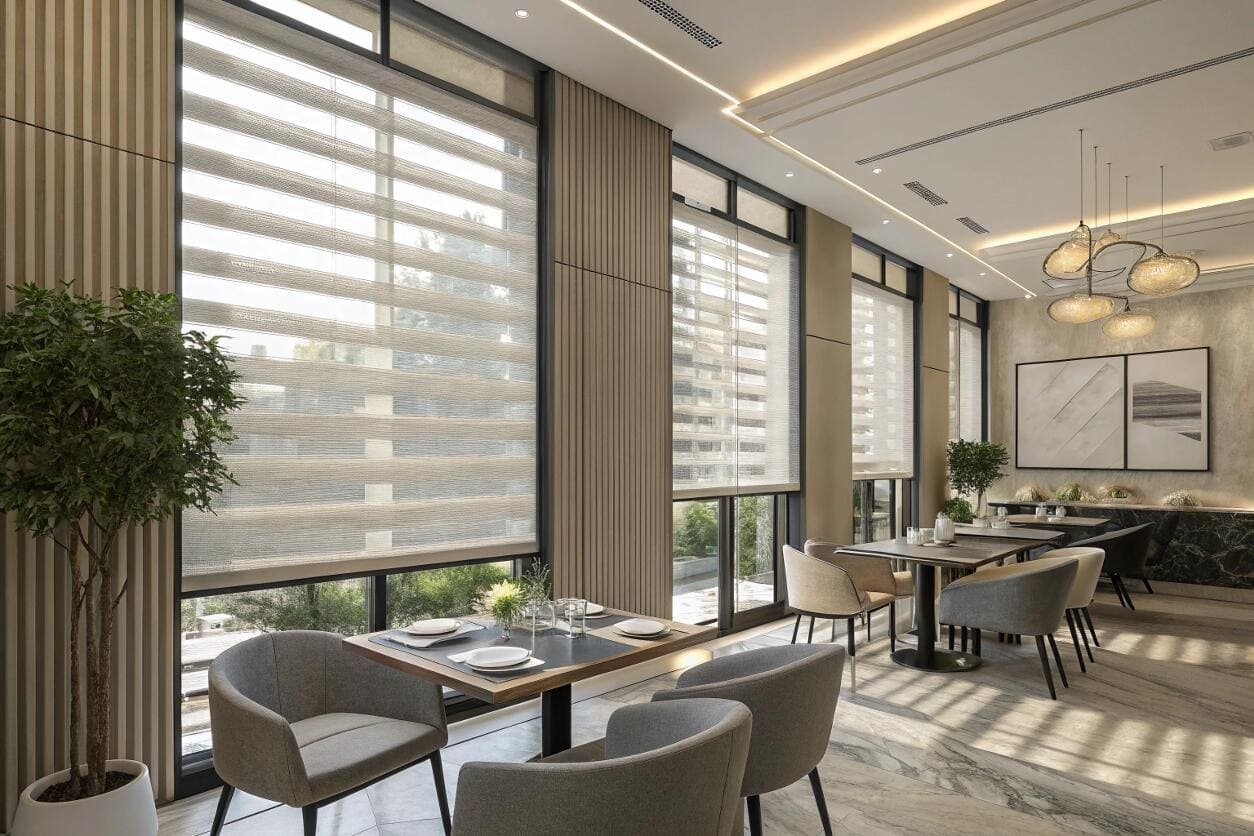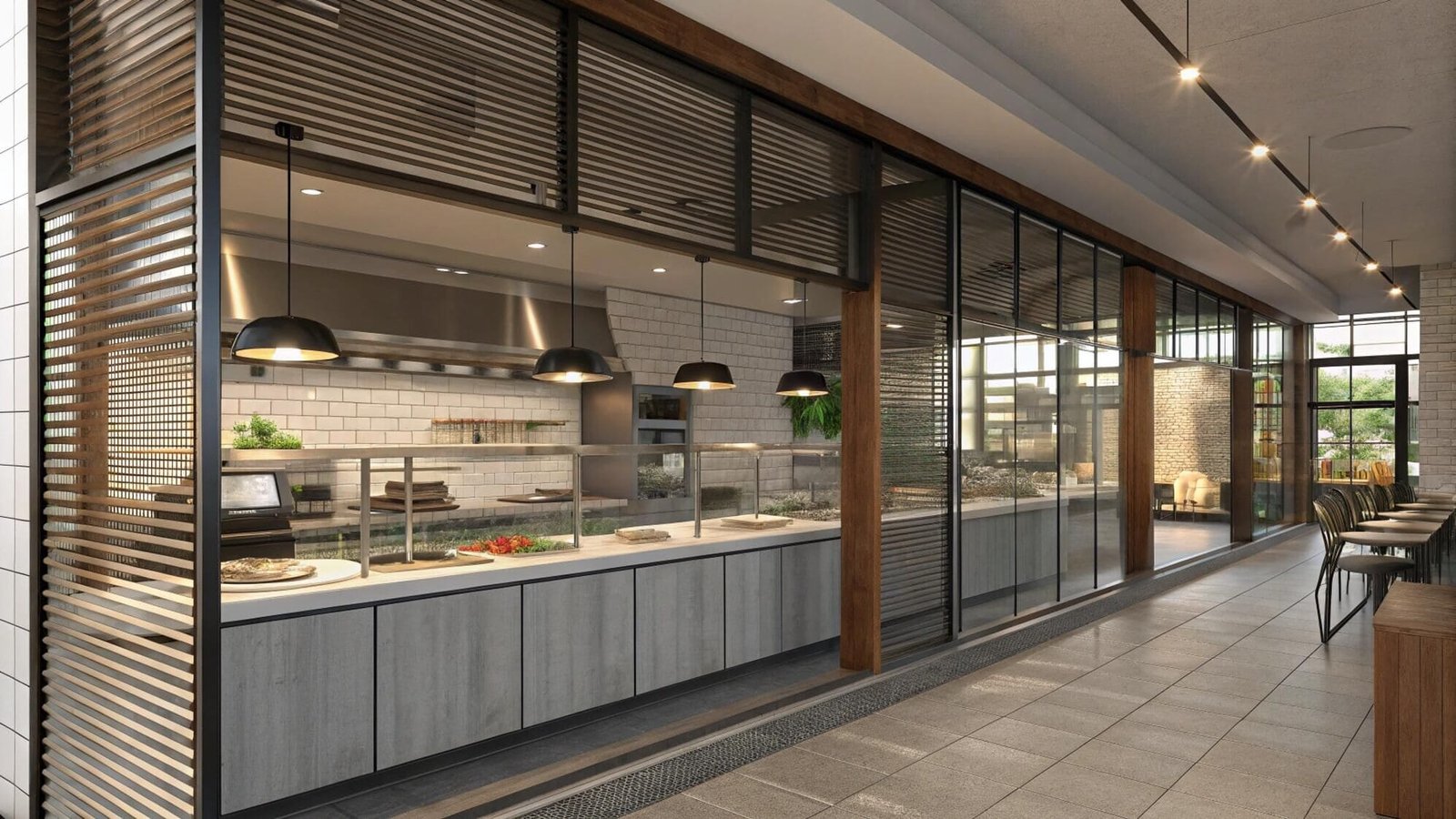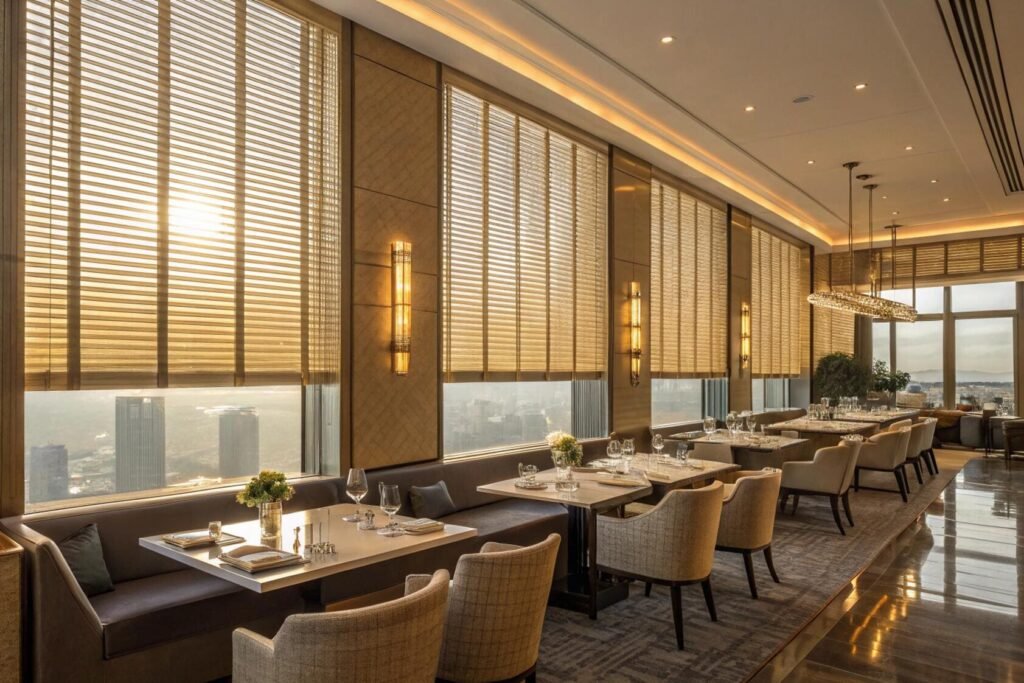Restaurant lighting disasters kill customer satisfaction instantly. Poor window treatments[^1] create glare, uncomfortable temperatures, and zero privacy control for diners.
Restaurant window blinds must balance natural light optimization, privacy control, temperature regulation, and aesthetic appeal while meeting commercial safety standards. The best solutions combine dual functionality with easy maintenance for high-traffic environments.

I've worked with hundreds of restaurant projects where window treatment decisions make or break the dining experience. The right blinds transform harsh sunlight into welcoming ambiance while controlling operational costs and maintaining code compliance.
What is the best window covering for restaurant windows?
Restaurant windows face unique challenges requiring specialized solutions. Multiple factors determine the optimal window treatment for each dining environment.
Dual roller shades with metallized fabric[^2] offer the best restaurant window solution, blocking up to 97% of UV rays while maintaining view control and easy maintenance for commercial kitchen environments.

Restaurant window treatments must address multiple operational requirements simultaneously. Temperature control becomes critical as direct sunlight can raise indoor temperatures by up to 20°F, significantly impacting HVAC costs and customer comfort. Dual roller shades with metallized fabric provide comprehensive sun protection while allowing staff to adjust light levels throughout different service periods.
The dual functionality proves essential for restaurant operations. The sunscreen fabric maintains exterior views during daytime service while blocking harmful UV rays that fade furniture and create uncomfortable glare for diners. The room-darkening metallized backing enables complete light control for evening events, private dining, or creating intimate atmospheres during different service periods.
Maintenance considerations significantly impact restaurant operations. Traditional fabric treatments require frequent cleaning due to cooking odors, grease, and high customer traffic. Metallized roller systems resist staining and odor absorption while providing easy wipe-down cleaning that meets health department standards[^3]. The smooth operation mechanism withstands thousands of daily adjustments without mechanical failure.
Commercial grade mounting systems accommodate the frequent use patterns typical in restaurant environments. Heavy-duty brackets and reinforced headrails support larger window spans common in dining areas while maintaining smooth operation throughout extended service hours. Professional installation ensures proper tension and alignment that prevents operational issues during peak service periods.
Fire safety compliance represents a critical consideration for commercial restaurant installations. Many jurisdictions require flame-retardant window treatments in commercial dining establishments. Metallized roller fabrics typically meet Class A fire ratings while maintaining their functional properties, ensuring code compliance without compromising performance.
How do I make windows private without blocking light?
Privacy control without sacrificing natural light requires sophisticated window treatment design. Restaurant dining areas need flexible privacy options for different service periods and customer preferences.
Zebra blinds[^4] and Shangri-La systems[^5] provide adjustable privacy control while maintaining natural light flow, perfect for restaurant environments requiring flexible ambiance throughout different service periods.

Zebra blind technology offers the ideal solution for restaurant privacy management. The alternating transparent and opaque fabric strips create adjustable privacy levels while maintaining natural light penetration. During daytime service, the transparent sections allow maximum light while providing subtle privacy screening. Evening service can adjust the opacity for more intimate dining experiences without completely blocking natural light sources.
The dual-fabric system enables precise light control throughout the day. Morning service may require maximum transparency to create bright, welcoming atmospheres that encourage breakfast and lunch traffic. Afternoon positioning can reduce glare during peak sun hours while maintaining view connections to street activity that attracts walk-in customers. Evening adjustments create intimate lighting conditions that enhance fine dining experiences.
Shangri-La blinds provide another excellent privacy solution through their soft fabric vanes that diffuse light while creating elegant visual barriers. The horizontal fabric strips float between sheer panels, creating sophisticated light filtering that maintains privacy without the harsh lines of traditional blinds. This design particularly suits upscale restaurants seeking refined aesthetics.
Operational flexibility proves crucial for restaurant success. Staff can quickly adjust privacy levels based on customer preferences, special events, or changing outdoor conditions. Private dining areas benefit from instant privacy control for business meetings or romantic dinners, while main dining areas can maintain open, welcoming atmospheres during peak service periods.
Light diffusion quality significantly impacts dining ambiance. Harsh direct sunlight creates uncomfortable glare and uneven lighting that affects food presentation and customer comfort. Quality privacy blinds soften natural light while maintaining adequate illumination for dining, reading menus, and social interaction. The filtered light creates more flattering environments that enhance the overall dining experience.
What window treatments work best in commercial kitchens?
Commercial kitchen environments demand specialized window treatments that withstand extreme conditions while maintaining functionality. Safety, hygiene, and durability requirements exceed standard commercial applications.
Aluminum venetian blinds with powder-coated finishes provide optimal commercial kitchen performance, offering easy sanitization, heat resistance, and precise light control while meeting health department requirements.

Heat resistance represents the primary requirement for kitchen window treatments. Commercial cooking operations generate extreme temperatures that can damage standard blind materials. Aluminum venetian blinds withstand high heat exposure without warping, discoloration, or mechanical failure. The metal construction maintains structural integrity even when positioned near cooking equipment or hot service areas.
Sanitation compliance requires window treatments that support rigorous cleaning protocols. Health departments mandate regular deep cleaning of all kitchen surfaces, including window treatments. Aluminum slats provide non-porous surfaces that resist bacterial growth while enabling complete sanitization using commercial cleaning products. The smooth metal surfaces prevent grease accumulation and odor absorption common with fabric treatments.
Chemical resistance becomes critical in commercial kitchen environments. Cleaning products, cooking vapors, and sanitizing solutions can damage standard window treatment materials. Powder-coated aluminum finishes resist chemical degradation while maintaining their appearance and functionality throughout extended exposure to harsh kitchen conditions.
Light control precision enables kitchen staff to optimize working conditions throughout different preparation periods. Early morning prep work requires maximum natural light for food inspection and detailed preparation tasks. Peak cooking periods may need reduced light to minimize heat gain and glare from cooking surfaces. The adjustable slat system provides infinite positioning options to match operational requirements.
Durability expectations far exceed residential applications due to constant use and harsh environmental conditions. Commercial kitchen blinds must withstand thousands of daily adjustments while maintaining smooth operation. Heavy-duty mechanisms and reinforced mounting systems ensure reliable performance throughout extended service periods without frequent maintenance or replacement requirements.
How to choose blinds for restaurant ambiance and mood?
Ambiance creation through window treatments directly impacts customer experience and restaurant success. Different dining concepts require specific approaches to light management and aesthetic integration.
Shangri-La blinds with soft fabric vanes create elegant light diffusion ideal for upscale dining, while roller systems offer clean, modern aesthetics perfect for casual dining environments.

Fine dining establishments require sophisticated light control that enhances the overall dining experience. Shangri-La blinds provide soft, diffused lighting that creates intimate atmospheres while maintaining elegant aesthetics. The floating fabric vanes create subtle visual interest without overwhelming interior design elements. The gentle light filtering flatters food presentation and creates comfortable environments for extended dining experiences.
Casual dining concepts benefit from clean, functional window treatments that support active, social atmospheres. Roller blinds offer streamlined aesthetics that complement modern interior design while providing reliable light control. The simple operation suits high-traffic environments where staff need quick, efficient adjustment capabilities throughout busy service periods.
Color selection significantly impacts perceived ambiance and brand alignment. Neutral tones provide versatile backgrounds that complement changing seasonal decorations and promotional displays. Warmer colors create inviting atmospheres suitable for family dining concepts, while cooler tones support contemporary, upscale positioning. The color choice should integrate with overall interior design themes while maintaining professional appearance standards.
Texture considerations affect both visual appeal and maintenance requirements. Smooth surfaces provide easy cleaning and maintain crisp, professional appearances that suit modern restaurant concepts. Textured materials can add visual interest and warmth but may require more intensive cleaning protocols to meet health department standards.
Light pattern effects created by different blind styles influence customer perception and comfort levels. Horizontal slat patterns create structured, organized feelings suitable for business dining environments. Soft, diffused patterns from fabric systems create relaxed, comfortable atmospheres that encourage longer visits and repeat customers. The pattern choice should align with target customer demographics and dining concept positioning.
What are fire-rated blinds for commercial restaurants?
Fire safety regulations mandate specific performance standards for commercial restaurant window treatments. Compliance requirements vary by jurisdiction but generally require flame-resistant materials and installation methods.
Class A fire-rated blinds[^6] with flame-retardant treatments meet commercial restaurant safety codes while maintaining functionality. Aluminum and specially treated fabric systems provide compliant solutions for different restaurant applications.

Fire safety classifications determine allowable window treatment materials in commercial dining establishments. Class A rated materials demonstrate the highest fire resistance, self-extinguishing within specified time limits while producing minimal smoke. These ratings apply to both the blind material and any mounting hardware or operational components.
Aluminum venetian blinds naturally provide excellent fire resistance due to their metal construction. The non-combustible material meets or exceeds fire safety requirements without additional treatments. Powder-coated finishes may require specific formulations to maintain fire ratings, but quality commercial-grade systems typically include compliant coating systems.
Fabric-based systems require special flame-retardant treatments to achieve commercial fire ratings. The treatment process must not compromise the fabric's functionality, appearance, or cleaning requirements. Quality manufacturers provide certification documentation confirming fire rating compliance for each product specification.
Installation requirements often include specific mounting methods and clearances from heat sources. Fire-rated installations may require metal mounting brackets and hardware that maintain fire resistance throughout the entire system. Professional installation ensures compliance with local fire codes and insurance requirements.
Maintenance protocols must preserve fire rating performance throughout the system's operational life. Cleaning products and procedures should not compromise flame-retardant treatments. Regular inspection schedules may be required to document continued compliance with fire safety regulations.
How often should restaurant blinds be cleaned and maintained?
Restaurant environments require intensive cleaning schedules that exceed standard commercial applications. Food service operations generate grease, odors, and contaminants that demand specialized maintenance protocols.
Restaurant blinds require weekly deep cleaning and daily maintenance checks to meet health department standards. High-traffic areas may need bi-weekly professional cleaning to maintain appearance and functionality.

Health department regulations establish minimum cleaning requirements for all surfaces in food service establishments. Window treatments fall under these regulations, requiring documentation of cleaning schedules and procedures. Weekly deep cleaning using approved sanitizing products ensures compliance while maintaining professional appearance standards.
Daily maintenance checks should include visual inspection for stains, damage, or operational issues that could affect customer experience. Kitchen area blinds require daily cleaning due to grease and cooking vapor exposure. Dining area treatments need daily dust removal and spot cleaning to maintain pristine appearance throughout service periods.
Grease accumulation presents unique challenges in restaurant environments. Cooking vapors can create sticky residues that attract additional contaminants and create odor problems. Specialized cleaning products designed for commercial kitchen applications effectively remove grease buildup without damaging blind materials or mechanisms.
Professional cleaning services may be necessary for large installations or complex window treatment systems. Commercial cleaning companies understand health department requirements and possess specialized equipment for thorough blind cleaning. Bi-weekly professional service combined with daily staff maintenance creates comprehensive cleaning programs.
Operational maintenance includes lubrication of moving parts, tension adjustments, and replacement of worn components. High-use restaurant environments accelerate wear patterns compared to standard commercial applications. Preventive maintenance schedules should include monthly operational checks and semi-annual professional service to ensure continued reliable performance throughout peak service periods.
Conclusion
Restaurant window blinds require careful balance of ambiance, functionality, safety compliance, and maintenance requirements to create successful dining environments that enhance customer experience and operational efficiency.
Extended FAQ Section
What window blind materials resist cooking odors and grease in restaurants?
Aluminum and vinyl materials provide superior resistance to cooking odors and grease accumulation compared to fabric systems in restaurant environments. Aluminum venetian blinds feature non-porous surfaces that prevent odor absorption while enabling complete sanitization using commercial cleaning products. The powder-coated finishes resist chemical degradation from cleaning agents while maintaining professional appearance standards. Vinyl roller systems offer similar benefits with smooth surfaces that repel grease and moisture. Quality commercial-grade materials include antimicrobial treatments that prevent bacterial growth while supporting health department compliance. Fabric systems require special treatments and more intensive cleaning protocols but can achieve acceptable performance with proper maintenance schedules. Material selection should consider both initial cost and long-term maintenance requirements, as aluminum systems typically provide lower total cost of ownership despite higher initial investment. Professional-grade mounting hardware and mechanisms must also resist grease accumulation and provide smooth operation throughout extended service periods in demanding restaurant environments.
How do restaurant blinds affect energy costs and HVAC efficiency?
Properly selected restaurant blinds can reduce HVAC costs by 15-25% through effective solar heat gain control and thermal insulation properties. Dual roller systems with metallized backing block up to 97% of solar heat gain, significantly reducing cooling loads during peak sun hours when restaurants typically experience highest customer traffic. Cellular honeycomb designs provide additional insulation benefits, reducing heat transfer by up to 60% compared to bare windows. Strategic positioning throughout the day optimizes natural lighting while minimizing thermal loads, particularly important for restaurants with large window areas. Automated systems can adjust blind positions based on time of day, season, and outdoor temperature to maximize energy efficiency without staff intervention. The investment in quality window treatments typically pays for itself within 18-24 months through reduced utility costs, while also improving customer comfort and reducing HVAC equipment wear. South-facing restaurant windows show the greatest energy savings potential, while north-facing installations provide consistent lighting benefits with minimal thermal impact throughout the year.
What are the key differences between residential and commercial restaurant blind requirements?
Commercial restaurant blinds must meet significantly higher performance standards including fire safety codes, health department regulations, and durability requirements that exceed residential applications. Fire rating classifications typically require Class A materials with documented flame resistance and smoke generation properties, while residential blinds may not require any fire rating compliance. Cleaning protocols demand non-porous materials that support sanitization using commercial-grade cleaning products, compared to basic dusting requirements for home installations. Durability expectations include thousands of daily adjustment cycles and resistance to grease, heat, and chemical exposure that would quickly destroy residential-grade systems. Professional installation requirements often mandate licensed contractors familiar with commercial building codes and accessibility compliance, while residential installations may allow DIY approaches. Warranty terms typically provide shorter coverage periods but include provisions for commercial use and professional maintenance requirements. Cost structures reflect these enhanced requirements, with commercial restaurant systems costing 40-80% more than comparable residential products due to upgraded materials, mechanisms, and compliance certifications necessary for food service environments.
Partner With Us for Professional Restaurant Solutions
Transform your restaurant's atmosphere while controlling operational costs with commercial-grade window treatments designed specifically for food service environments. Our systems meet all health department requirements while delivering the ambiance control your concept demands.
Skip the guesswork and get expert recommendations tailored to your restaurant type, budget, and local compliance requirements. We provide complete specifications, fire rating documentation, and maintenance protocols within 24 hours.
Contact our restaurant specialists today for your custom solution: info@velablinds.com
---
[^1]: Explore various window treatment options to enhance ambiance and functionality in dining spaces.
[^2]: Understand the advantages of using metallized fabric for effective light and heat management.
[^3]: Stay compliant with health regulations by understanding the standards for window treatments.
[^4]: Discover how Zebra blinds can enhance privacy while allowing natural light to flow.
[^5]: Explore the unique features of Shangri-La systems for flexible privacy solutions.
[^6]: Learn about fire-rated blinds to ensure safety and compliance in your dining establishment.Partner with VelaBlinds for Your Next Project
Smart window treatments shouldn't be complicated. After working with 500+ distributors and contractors worldwide, I've streamlined the process to get you quality products, competitive pricing, and reliable support - every time.
Why project professionals choose VelaBlinds:
- ✅ Fast, Accurate Quotes - Detailed specs and pricing within 24 hours
- ✅ Transparent Pricing - No hidden fees, volume discounts clearly outlined
- ✅ Quality Assurance - Direct partnerships with certified OEM manufacturers
- ✅ Project Support - Dedicated account manager from quote to delivery
Start your next project:
📧 Quick Quote: Send your requirements to info@velablinds.com
📱 Direct Contact: WhatsApp +86 137 2012 8317
🌐 Browse Solutions: https://velablinds.com/
📁 Product Resources: Access spec sheets, catalogs & project files
Jimmy Chen, Founder
"I built VelaBlinds to solve the real challenges I faced as a project buyer - long lead times, unclear specs, and unreliable suppliers. Let's discuss how we can power your projects with smarter blinds."
Serving distributors and contractors across North America, Europe, and Australia since 2018.




